Christopher was one of the giants of positive psychology and did pioneering work in the field.
He produced two prodigious books that helped to establish the approach. These are A Primer In Positive Psychology and, together with Martin Seligman, Character Virtues and Strengths.
He wrote an ongoing blog for Psychology Today. This was called The Good Life: Positive psychology and what makes life worth living.
He received awards for outstanding teaching. One of these was The Golden Apple Award, voted for by students at The University of Michigan, where he was the Professor of Psychology and Organizational Studies.
The Books
George Vaillant, Senior Physician at Harvard Medical School, offered the following description of this book.
“Peterson offers his readers a marvelous blend of lucidity, originality, humor, kindness and scholarship. This is a book that should entice many thousands of readers into a lifetime of interest in psychology.”
Mihaly Csikszentmihalyi, the author of Flow, wrote:
“Chris Peterson, one of the founding fathers of Positive Psychology, has written a wonderfully engaging and deeply stimulating introduction to this swiftly growing field. Intellectual history is interwoven with data, research findings with backstage gossip, to produce a delightful classic.”
The book takes readers on a remarkable journey through Positive Psychology. Featuring a comprehensive Who’s Who of people in the field, the chapter titles include:
Happiness.
Character Strengths.
Values.
Interests, Abilities and Accomplishments.
Wellness.
Enabling Institutions.
The Future of Positive Psychology.
This book stands alongside another volume as one of the key foundations for Positive Psychology. This second book is Character Strengths and Virtues. Chris wrote this with Martin Seligman and a group of distinguished collaborators.
Positive Psychology is the scientific study of human beings at their best. This includes exploring the field of human virtues. These are the qualities of moral excellence that are admired across different philosophies, religions and cultures.
There are obviously many views on how people should live a good life. Chris, Martin and their colleagues collected data on both the philosophical guidelines and practical examples of moral excellence in different cultures.
After extensive research, the team settled on six key virtues, though these are obviously interlinked. Each virtue included several key strengths. Here is an overview of these qualities.
There are many other approaches to exploring human virtues. But this volume provides an excellent starting point.
The Blog and Teaching
Chris was a gifted educator. He was dedicated to sharing knowledge that enabled people to shape their futures and live fulfilling lives. He used many vehicles for making this happen.
One approach he used was a blog in Psychology Today. This covered topics such as:
The King’s Speech from a Positive Psychology Perspective.
What’s On Your iPod? Music Preferences and Personality
When Losing Isn’t Losing.
This final piece is about the Washington Generals. They were the basketball team that always played against The Harlem Globetrotters on tour.
So how does such a team ‘win’: even when one of their players routinely has their pants pulled down during the game and the crowd wants the Globetrotters to win? You can find his blog at:
http://www.psychologytoday.com/blog/the-good-life
Chris summed up his approach to positive psychology in three words: “Other people matter.”
His ability to live this message was acknowledged by students at the University of Michigan. In 2011 they honoured him with The Golden Apple Award for outstanding teaching. Students described the positive impact he had made on their lives.
One person added: “Chris is a great teacher not because he is perfect, but because he never stops trying to be a better one.”
You can discover more at the following link.
http://www.michigandaily.com/content/psychology-prof-peterson-gets-golden-apple-award
Strengths
Chris obviously covered a vast amount of ground. Looking at his work on strengths, one of the key challenges he faced was defining the possible criteria for signature strengths.
Writing in 2004, he settled on some of the following characteristics that might make up such a strength.
a sense of ownership and authenticity (“this is the real me”) vis-a-vis the strength
a feeling of excitement while displaying it, particularly at first
a rapid learning curve as themes are attached to the strength and practiced
continuous learning of new ways to enact the strength
a sense of yearning to act in accordance with the strength
a feeling of inevitability in using the strength, as if one cannot be stopped or dissuaded from its display
the discovery of the strength as owned in an epiphany
invigoration rather than exhaustion when using the strength
the creation and pursuit of fundamental projects that revolve around the strength
intrinsic motivation to use the strength
Chris, who died in 2012, did pioneering work in Positive Psychology. One of the best places to explore his research is at The VIA Institute, where he worked with colleagues such as Martin Seligman and Neal Mayerson. Their Home Page says:
The VIA Institute on Character, a non-profit organization, advances the science and practice of character development.
We provide the free VIA Surveys (strengths assessment) and other measures designed to help all people live their best lives.
We also provide continuing education worldwide.
You can explore VIA’s superb work at the following link. The organisation continues to build on the firm foundations established by their research, such as the monumental Character Strengths and Virtues.


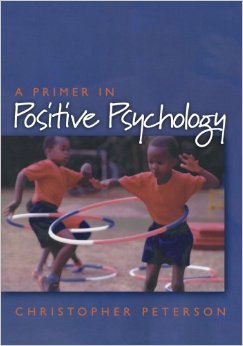
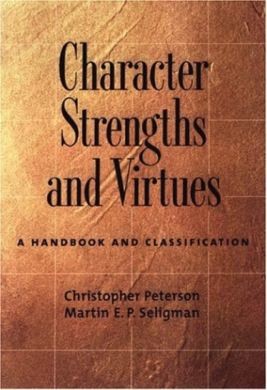
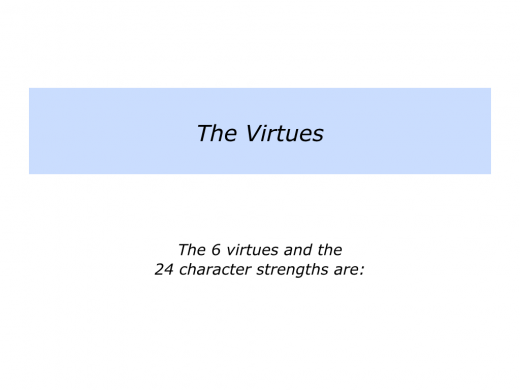
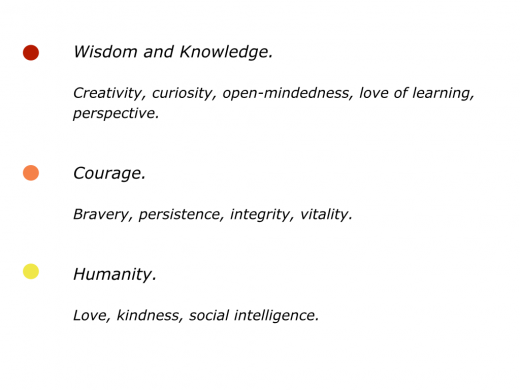
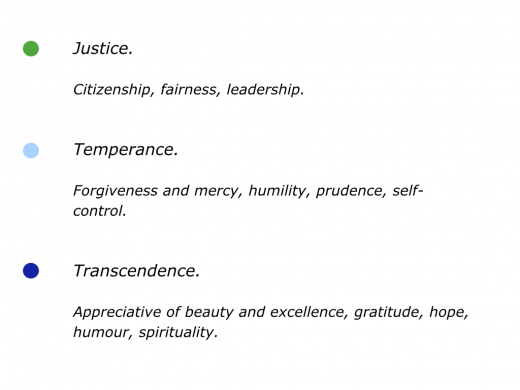




Leave a Reply